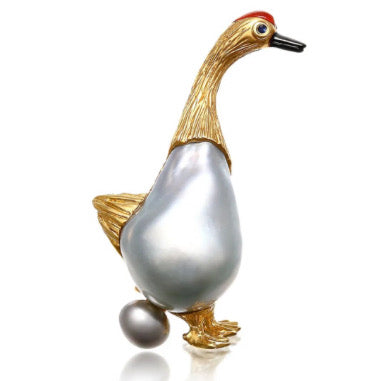Pearls in our impression are perhaps selected based on their round and lustrous qualities. However, with the diversity of aesthetics, more and more people are falling in love with the spontaneous growth of baroque pearls. Baroque pearls have also graced numerous fashion magazines and runway shows, entering the public’s field of view.
I. An Introduction to Baroque Pearls:
Baroque pearls, also known as irregular pearls, derive their name from the Baroque artistic style that celebrates elaborate diversity and irregular forms. Their unconventional, almost whimsical shapes align with the principles of the Baroque era. These pearls play a significant role in the hands of designers, as their idiosyncratic and unconventional nature can be transformed into artistic masterpieces. Each seemingly ordinary Baroque pearl possesses the potential to evolve into an extraordinary work of art through thoughtful design. The interplay between the distinct shapes of Baroque pearls and the personal interpretation of each designer contributes to the captivating allure of these pearls.

II. The Beauty of Imperfection: Baroque Pearls' Unconventional Charm
Baroque pearls encapsulate both classical and imperfect beauty, much like the iconic Venus de Milo sculpture. It is precisely in their imperfection that they find space for imagination and wonder. "I am particularly drawn to the pearls with poignant stories and melancholic allure," says Japanese artist Yoshitaka Nishikawa. When observed up close, the radiant splendor emitted by these pearls is truly breathtaking. Their unique beauty, quite distinct from the standard spherical pearls, emanates from their individuality, natural form, and the effort to showcase an alternative grace that exudes captivating allure.



III. Baroque Pearl Origins from Around the World
Baroque pearls are found in various locations across the globe, existing wherever pearls are cultivated, whether in freshwater or saltwater. In China, for instance, Baroque pearls are primarily sourced from regions like Zhejiang and Anhui. These pearls are mainly wild and untouched by human intervention, resulting in their distinctive and unparalleled shapes.


IV. Appreciating Baroque Pearls Worldwide
Discovered in the Philippines in 1943, the "Pearl of Lao Tzu" remains the largest known Baroque pearl in the world, weighing an astounding 6350 grams. Its dimensions are 241mm in length and 139mm in width, resembling the ancient Chinese philosopher Laozi. This pearl has been endearingly referred to as "Pearl of Lao Tzu" or "Balaong" due to its resemblance to Laozi's visage.
As time has progressed, Baroque pearls have broken free from being confined to a singular style. Contemporary designers take inspiration from their unique forms, creating an array of designs that showcase the inherent beauty of Baroque pearls. The irregularities that were once considered imperfections are now embraced as raw characteristics, amplified by innovative designs. Baroque pearls no longer succumb to the fate of being ground into powder due to irregularity; instead, they flourish under the hands of designers. Each designer's interpretation and understanding of Baroque pearls magnify their extraordinary essence. This amalgamation of their uniqueness, oceanic spirit, and the designer's vision culminate in pieces that cannot be replicated—beauty that defies definition.


